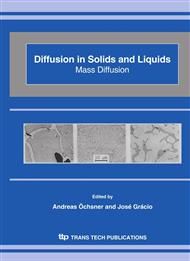[1]
M. A. Lamkin, F. L. Riley, and R. J. Fordham. J. Europ. Cer. Soc., 10: 347-367, (1992).
Google Scholar
[2]
J. C. Mikkelsen. Appl. Phys. Lett., 45: 1187, (1984).
Google Scholar
[3]
G. Brebec, R. Seguin, C. Sella, J. Bevenot, and J. C. Martin. Acta Metall., 28: 327-333, (1980).
DOI: 10.1016/0001-6160(80)90168-6
Google Scholar
[4]
O. Jaoul, F. B´ejina, F. ´Elie, and F. Abel. Phys. Rev. Lett., 74: 2038, (1995).
Google Scholar
[5]
R. Tromp, G. D. Rubloff, P. Balk, F. K. LeGoues, and E. J. van Loenen. Phys. Rev. Lett., 55: 2332-2335, (1985).
Google Scholar
[6]
D. Tsoukalas, C. Tsamis, and J. Stoemenos. Appl. Phys. Lett., 63: 3167-3169, (1993).
Google Scholar
[7]
D. Tsoukalas, C. Tsamis, and P. Normand. J. Appl. Phys., 89: 7809-7813, (2001).
Google Scholar
[8]
D. Mathiot, J. P. Schunck, M. Perego, M. Fanciulli, P. Normand, C. Tsamis, and D. Tsoukalas. J. Appl. Phys., 94: 2136-2138, (2003).
DOI: 10.1063/1.1589168
Google Scholar
[9]
T. Takahashi, S. Fukatsu, K. M. Itoh, M. Uematsu, A. Fujiwara, H. Kageshima, and Y. Takahashi. J. Appl. Phys., 93: 3674-3676, (2003).
DOI: 10.1063/1.1554487
Google Scholar
[10]
M. Uematsu, H. Kageshima, Y. Takahashi, S. Fukatsu, K. M. Itoh, K. Shiraishi, and U. G¨osele. Appl. Phys. Lett., 84: 876, (2004).
Google Scholar
[11]
Guido Roma, Yves Limoge, and Stefano Baroni. Phys. Rev. Lett., 86: 4564, (2001).
Google Scholar
[12]
S. Baroni, A. Dal Corso, S. de Gironcoli, and P. Giannozzi, (2001).
Google Scholar
[13]
P. Ordej´on, E. Artacho, and J. M. Soler. Phys. Rev. B, 53: 10441, (1996).
Google Scholar
[14]
Layla Martin-Samos, Yves Limoge, Jean-Paul Crocombette, Guido Roma, Nicolas Richard, Eduardo Anglada, and Emilio Artacho. Phys. Rev. B, 71: 014116-12, (2005).
DOI: 10.1103/physrevb.71.014116
Google Scholar
[15]
L. Martin-Samos, Y. Limoge, N. Richard, J. P. Crocombette, G. Roma, E. Anglada, and E. Artacho. Europhys. Lett., 66: 680-686, (2004).
DOI: 10.1209/epl/i2003-10247-3
Google Scholar
[16]
G. Makov and M. C. Payne. Phys. Rev. B, 51: 4014, (1995).
Google Scholar
[17]
J. Shim, E. -K. Lee, and R. M. Nieminen. Phys. Rev. B, 71: 35206-12, (2005).
Google Scholar
[18]
U. Gerstmann, P. De´ak, R. Rurali, B. Aradi, Th. Frauenheim, and H. Overhof. Physica B, 340- 342: 190-194, (2003).
DOI: 10.1016/j.physb.2003.09.111
Google Scholar
[19]
A. Baldereschi, S. Baroni, and R. Resta. Phys. Rev. Lett., 61: 734-737, (1988).
Google Scholar
[20]
G. Roma and Y. Limoge. Phys. Rev. B, 70: 174101-6, (2004).
Google Scholar
[21]
M. Pesola, J. von Boehm, T. Mattila, and R. M. Nieminen. Phys. Rev. B, 60: 11449-11463, (1999).
DOI: 10.1103/physrevb.60.11449
Google Scholar
[22]
C. H. Bennett. Diffusion in Solids: Recent developments, page 73. Academic Press, New York, (1975).
Google Scholar
[23]
G. Mills and H. J´onsson. Phys. Rev. Lett., 72: 1124, (1994).
Google Scholar
[24]
Layla Martin-Samos. ´Etude ab-initio des auto-d´efauts et des m´ecanismes d'auto-diffusion dans un verre de silice. PhD thesis, Universit´e de Cergy-Pontoise, (2004).
Google Scholar
[25]
L. Martin-Samos, G. Roma, Y. Limoge, and N. Richard. Silica and µe. to be published.
Google Scholar
[26]
L. Martin-Samos, Y. Limoge, G. Roma, and N. Richard. Silicon diffusion. to be published.
Google Scholar
[27]
Young-Gu Jin and K. J. Chang. Phys. Rev. Lett., 86: 1793, (2001).
Google Scholar
[28]
J. D. Kalen, R. S. Boyce, and J. D. Cawley. J. Am. Ceram. Soc., 74: 203, (1991).
Google Scholar
[29]
M. Tomozawa, H. Li, and K. M. Davis. J. Noncryst. Sol., 179: 162, (1994).
Google Scholar
[30]
J. C. Mikkelsen. J. Elec. Mater., 11: 541, (1982).
Google Scholar
[31]
G. Roma and Y. Limoge. Def. Diff. Forum, 237-240: 127, (2005).
Google Scholar
[32]
G. Roma, Y. Limoge, and L. Martin-Samos. Nucl. Inst. Meth. B, 250: 54-56, (2006).
Google Scholar
[33]
S. Fukatsu, T. Takahashi, K. M. Itoh, M. Uematsu, A. Fujiwara, H. Kageshima, Y. Takahashi, K. Shiraishi, and U. G¨osele. Appl. Phys. Lett., 83: 3897, (2003).
DOI: 10.1063/1.1625775
Google Scholar


